#LoRaWAN module
Text

Deep Dive into the Core Technology and Applications of the LoRaWAN Gateway
The wireless communication landscape is vast and evolving, and at its forefront is the LoRaWAN Gateway. This key piece of technology acts as the bridge in the entire LoRaWAN network, ensuring that data can move seamlessly between devices, cloud systems, and other essential infrastructure components.
At the heart of the LoRaWAN network's architecture lies the LoRaWAN Gateway. Its primary function is to capture information sent from a multitude of endpoint devices, process it, and then forward it to the network server. This mechanism ensures that data flows coherently and efficiently, minimizing losses and ensuring timely communication. What makes this even more interesting is the kind of devices the gateway interacts with. These devices, which include sensors, actuators, and other IoT components, are typically powered by a LoRaWAN module.
The LoRaWAN module's genius lies in its ability to transmit low-power signals across extensive distances. In a world where energy efficiency is paramount, having such a module aids in reducing overall power consumption, thus contributing to sustainable and long-lasting solutions. The versatility of the LoRaWAN Gateway, combined with its multi-channel capabilities, means that it can simultaneously handle signals from thousands of LoRaWAN modules. This not only boosts the network's scalability but also enhances its overall capacity, making it fit for a broader range of applications.
The rise of the Internet of Things (IoT) has further accelerated the demand for the LoRaWAN Gateway. As more devices come online, the need for reliable, secure, and long-range communication platforms becomes evident. LoRaWAN technology, with its unique blend of long-range transmission capabilities, low power requirements, and robust security features, positions itself as the ideal solution for this growing demand. Recognizing the potential and the requirements of the current market, industry leaders are now focusing more on the development and production of even more efficient and reliable LoRaWAN modules.
Moreover, as industries evolve, there's an increasing emphasis on real-time data collection, analytics, and smart decision-making. The LoRaWAN Gateway, with its enhanced data processing capabilities, becomes a crucial player in this scenario. It not only facilitates the collection of data but also ensures that it is forwarded to the necessary systems for analysis and subsequent actions.
In wrapping up, the role of the LoRaWAN Gateway in today's wireless communication networks is more significant than ever, particularly in the context of IoT applications. As the world becomes more interconnected and reliant on real-time data, investing in understanding, developing, and integrating LoRaWAN Gateways and associated LoRaWAN modules will be the cornerstone for any company or individual aiming for success in the wireless communication domain.
For details, please click: https://www.nicerf.com/collection/lorawan-gateway-and-node
Or click:https://www.alibaba.com/product-detail/G-NiceRF-High-Power-Front-End_1600914259171.html?spm=a2747.manage.0.0.29ed71d2fPp5Ld
For consultation, please contact NiceRF (Email: [email protected]).
0 notes
Text
GPIOs do LoRaMesh da Radioenge: Portas digitais
Aprenda como usar as GPIOs do módulo LoRaMesh da Radioenge
As GPIOs do LoRaMesh da Radioenge possibilita que possamos fazer aplicações de automação com um uso reduzido de hardware, dedicando apenas ao circuito de chaveamento (se necessário) e de alimentação.
No total temos no LoRaMesh 8 GPIOs sendo todas configuráveis como entrada ou saída digital e duas como leitura analógica. Porém neste post vamos apenas abordar as portas digitais.
Por qual motivo…
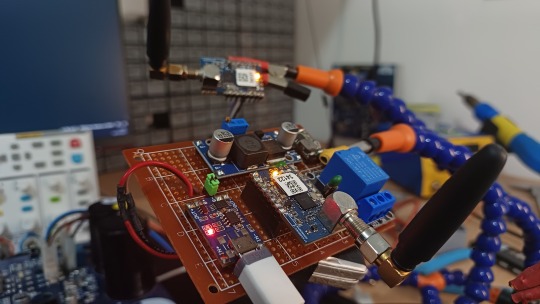
View On WordPress
#lora mesh arduino#lora mesh chat#lora mesh device#lora mesh library#lora mesh module#lora mesh network#lora mesh network raspberry pi#lora mesh protocol#lora mesh radio#lora mesh range#lora vs lorawan#loramesh#lorawan#lorawan devices#lorawan gateway#lorawan network#mesh lora
0 notes
Text

The SX1262 is an updated LoRa chip, so we made a breakout 📡🔧🔄
We got a hot tip to check out the Semtech SX1262 (https://www.digikey.com/short/504bpwww) - compared to our classic SX127x series of "RadioFruit" boards (https://www.adafruit.com/product/3072) the '1262 has lower power usage and longer range as well as some more options for spread-spectrum and extra modulation protocols. Most folks will probably use it for LoRa / LoRaWAN. The pinout is slightly different, so a few changes were made to the classic PCB. We also had some extra room, so we tossed in mounting holes. With this design, you can use wire, uFL, or SMA antennas - just solder whichever connector you desire. Note that the new chips are not software-compatible, so some driver tweaks will be needed to make it work. Coming soon.
#adafruit#lora#semtech#sx1262#longrange#lowpower#wirelesscommunication#radiotechnology#pcbdesign#antennadesign#iotdevices
8 notes
·
View notes
Text
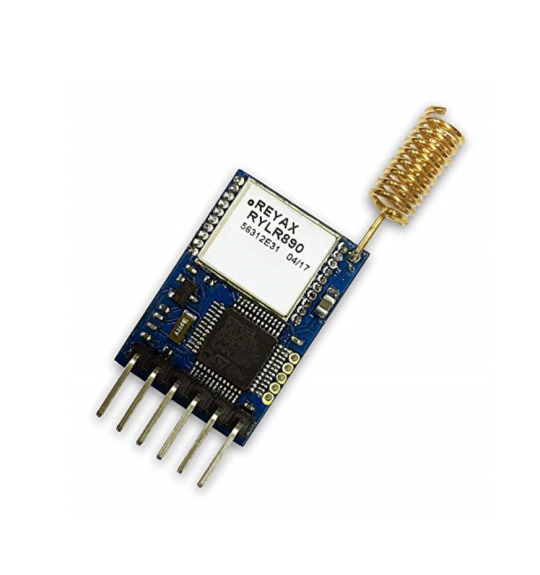
LoRa communication Module

youtube
:
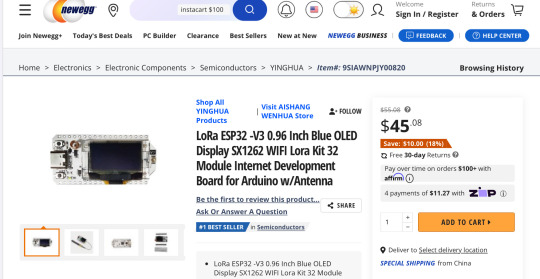
. https://www.newegg.com/p/2A3-00UG-000J9
youtube
.
.
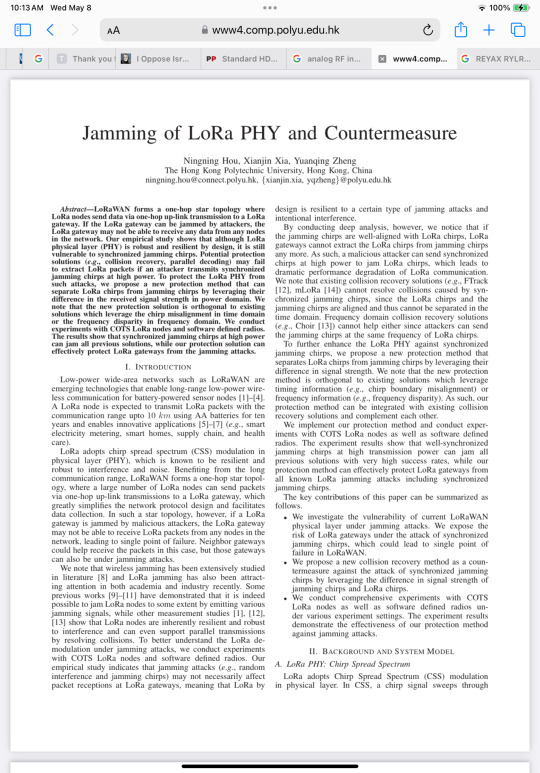
. https://www4.comp.polyu.edu.hk/~csyqzheng/papers/LoRaJamming-INFOCOM21.pdf
2 notes
·
View notes
Text
Embedded Software Design Services: Trends and Innovations

In the fast-paced world of technology, embedded software design is a crucial element driving the success of modern electronic devices. As industries continue to evolve, so do the methodologies and technologies shaping embedded software design services. This blog explores the latest trends and innovations that are transforming the field, highlighting how these developments are enhancing performance, efficiency, and capabilities.
The Rise of AI and Machine Learning Integration
Artificial Intelligence (AI) and Machine Learning (ML) are no longer just buzzwords—they’re integral components of contemporary embedded software design. AI and ML algorithms are being embedded directly into devices, allowing for real-time data analysis and decision-making. This integration enables devices to learn from their environment and adapt their behavior, resulting in smarter and more efficient systems.
For example, AI-driven predictive maintenance in industrial equipment helps anticipate failures before they occur, reducing downtime and maintenance costs. In consumer electronics, AI enhances user experiences by personalizing recommendations and improving interaction through natural language processing.
Growing Importance of Edge Computing
Edge computing is revolutionizing embedded systems by shifting data processing closer to the source of data generation. This trend is particularly significant for applications requiring low latency and high-speed processing, such as autonomous vehicles and industrial automation.
By processing data at the edge, embedded systems can deliver faster responses and reduce the need for constant communication with central servers. This approach not only enhances performance but also improves data privacy and security by minimizing the amount of sensitive information transmitted over networks.
Advances in IoT Connectivity
The Internet of Things (IoT) continues to expand, and with it, the demand for robust and reliable connectivity solutions in embedded systems. Innovations in IoT connectivity, such as 5G technology, are driving new possibilities for embedded software design.
5G networks offer significantly higher speeds and lower latency compared to previous generations, enabling real-time communication and data exchange between devices. This is crucial for applications like smart cities, where numerous devices need to work seamlessly together to optimize resources and services.
Moreover, advancements in wireless protocols, such as Bluetooth 5.0 and LoRaWAN, are enhancing connectivity for various IoT applications, from wearables to agricultural sensors. These technologies provide improved range, lower power consumption, and better interference resistance.
Enhanced Security Measures
As embedded systems become more interconnected, security remains a top priority. The rise in cyber threats and data breaches underscores the need for robust security measures in embedded software design.
Innovations in cybersecurity for embedded systems include the implementation of advanced encryption techniques, secure boot mechanisms, and real-time threat detection systems. These measures help safeguard sensitive information and ensure the integrity of embedded devices against potential attacks.
Additionally, the use of hardware security modules (HSMs) and trusted execution environments (TEEs) is becoming more common. These technologies provide isolated environments for sensitive operations, adding an extra layer of protection to embedded systems.
Focus on Energy Efficiency
Energy efficiency is a critical consideration in embedded software design, especially for battery-powered devices and systems operating in remote or challenging environments. The trend towards energy-efficient design is driven by the need to extend battery life and reduce the environmental impact of electronic devices.
Recent innovations in low-power design techniques, such as dynamic voltage and frequency scaling (DVFS) and energy-efficient coding algorithms, are helping to minimize power consumption without compromising performance. Additionally, the development of energy-harvesting technologies is enabling devices to generate their own power from environmental sources, further enhancing sustainability.
Adoption of Modular and Scalable Architectures
Modular and scalable architectures are gaining traction in embedded software design, offering greater flexibility and ease of customization. Modular design allows for the creation of reusable components that can be easily adapted or replaced as needed, reducing development time and costs.
Scalable architectures enable systems to grow and evolve with changing requirements. This approach is particularly valuable in industries like telecommunications and automotive, where systems must be able to accommodate future upgrades and expansions without requiring a complete redesign.
The Role of Open-Source Software
Open-source software is playing an increasingly important role in embedded systems development. By leveraging open-source platforms and tools, developers can access a wealth of resources and collaborate with a global community of contributors. This fosters innovation and accelerates development cycles.
Open-source projects such as Linux-based operating systems and middleware frameworks provide a robust foundation for embedded software design. They offer flexibility, customization options, and a broad range of features that can be tailored to specific applications.
Embracing Agile Development Practices
Agile development practices are transforming the way embedded software is designed and developed. Agile methodologies, such as Scrum and Kanban, emphasize iterative development, collaboration, and responsiveness to change.
These practices enable development teams to adapt quickly to evolving requirements and incorporate feedback more effectively. By adopting agile approaches, organizations can improve project outcomes and deliver high-quality embedded software that meets user needs and expectations.
Conclusion
The landscape of embedded software design services is rapidly evolving, driven by advancements in AI, edge computing, IoT connectivity, and more. By staying abreast of these trends and innovations, organizations can leverage cutting-edge technologies to create smarter, more efficient, and secure embedded systems. Embracing these changes will not only enhance the capabilities of embedded devices but also position businesses at the forefront of technological progress.
To Know More About ,
#embedded systems#iot#embedded software#embedded software development#embedded design#embedded system#embedded
0 notes
Text
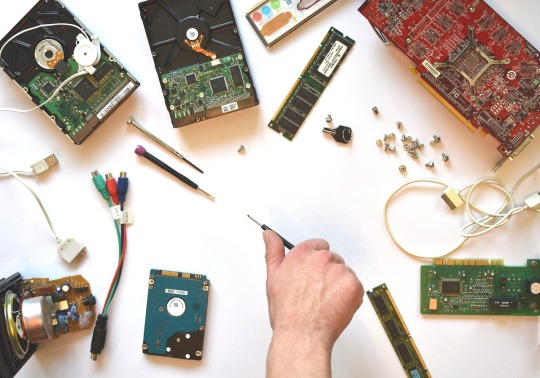
These days, some development boards come with an absolutely astounding variety of hardware. The EESP32, a tiny LoRa board with WiFi, Bluetooth, a transceiver that spans a large portion of the UHF band, and conveniences like OLED displays and an abundance of GPIO, are a perfect example. What about the documentation and firmware, though? Basically, do not say anything at all if you can not say something kind. Better yet, just take a roll.
That is not true for every LoRa dev board available, of course, but [Rop] found that to be the case with the Heltec HTIT-WB32LA. This board needed some assistance to get over the line, but it has all the bells and whistles and would be ideal for LoraWAN and Meshtastic applications. Based on his fork of the RadioLib library, which includes a library that significantly lessens wear on the ESP32's flash memory, [Rop] has contributed a fair amount to this end. The library supports all of the hardware on the board, including the pushbutton, display, power management, battery charging, and blinkers, in addition to complete radio support.
Many sample applications are included in [Jop], ranging from the minimal requirements to spin up the board to a fully functional spectrum analyzer. It is a wonderful piece of work and a wonderful way to support the LoRa community. And if you want to put one of these modules to work, you’re certainly in the right place. We’ve got everything from LoRaWAN networks to the magic of Meshtastic, so take your pick and get hacking.
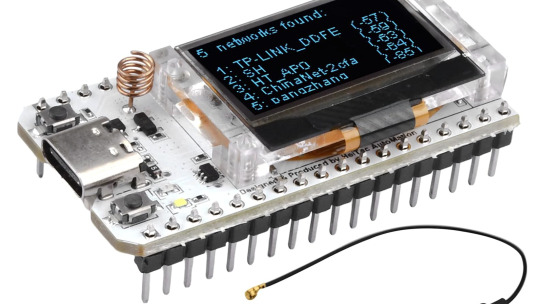
1 note
·
View note
Text
THE INSTALLED BASE OF GNSS-BASED ON-BOARD UNITS FOR ROAD USER CHARGING SURPASSES 7 MILLION WORLDWIDE._DYNAMIC NUMERICAL DATA AND INDUSTRY INSIGHTS UNVEILED.

Home General IoT News IoT Market IoT Solutions & Innovations Industrial IoT – IIoT Monitoring & Tracking Smart Cities & Smart Homes Auto & Telematics Fleet Management Consumer IoT & Wearables Digital Healthcare Smart Retail & Payment
New Information That Drives Digital Growth
Welcome to the IoT Business News blog! We are excited to share with you the latest and most insightful information in the world of technology. In this article, we will focus on highlighting key facts, hard data, numbers, and concrete information that will provide you with a deeper understanding of the IoT landscape. Our goal is to bring new, polarizing, numerical, objective, informative hard facts to the table. We will present you with technical, professional, and scientific terms to provide practical insight that matters to you. At the end of this article, we will introduce you to RoamNook, a technology company specialized in IT consultation, custom software development, and digital marketing that aims to fuel digital growth.
The Installed Base of GNSS-Based On-Board Units Deployed for Road User Charging Exceeds 7 Million Units Worldwide
According to a recent report, the installed base of GNSS-based on-board units deployed for road user charging has exceeded 7 million units worldwide. This is a significant milestone that showcases the widespread adoption of this technology in the transportation industry. Road user charging systems rely on satellite navigation and positioning technology to accurately track and charge vehicles for their usage of road infrastructure. With over 7 million units in operation, it is clear that this technology is here to stay.
The Installed Base of Wireless IIoT Devices in the Oil and Gas Industry to Reach 18.8 Million by 2028
Another remarkable statistic is the projected growth of the installed base of wireless IIoT devices in the oil and gas industry. It is estimated that by the year 2028, this number will reach an impressive 18.8 million. The oil and gas industry heavily relies on IoT devices to monitor and optimize their operations, leading to increased efficiency and cost savings. With such a vast number of devices deployed, it is evident that the industry recognizes the benefits and value brought by IoT solutions.
Bytesnap Releases IoT Standards and Protocols Guide for World IoT Day 2024
In celebration of World IoT Day 2024, Bytesnap, a leading IoT development company, has released an extensive guide on IoT standards and protocols. This guide aims to provide developers and industry professionals with a comprehensive overview of the different standards and protocols used in IoT systems. By standardizing communication and data exchange, IoT devices can seamlessly integrate and work together, maximizing their potential and enabling more sophisticated applications.
LoRa Alliance® Returns to Europe with LoRaWAN® Live Munich
The LoRa Alliance®, an open, nonprofit association, is returning to Europe with LoRaWAN® Live Munich. This event will bring together industry experts, innovators, and thought leaders to discuss the latest advancements in LoRaWAN® technology. LoRaWAN® is a low-power, wide-area network (LPWAN) protocol that enables long-range communication between IoT devices. With LoRaWAN® Live Munich, the LoRa Alliance® aims to foster collaboration and drive innovation in the European IoT ecosystem.
Murata's Multi-Band LoRa® Radio Module Simplifies Wireless Design and Supply-Chain Management for IoT Device Developers
Murata, a global leader in electronic components and solutions, has developed a multi-band LoRa® radio module that simplifies wireless design and supply-chain management for IoT device developers. This module supports multiple frequency bands, allowing IoT devices to operate worldwide without the need for separate hardware versions. By offering a flexible and cost-effective solution, Murata enables developers to bring their IoT devices to market faster and more efficiently.
Next-Level Learning: Unlocking Potential with State-of-the-Art Educational Technologies
The field of education is undergoing a rapid transformation with the emergence of state-of-the-art educational technologies. These technologies, such as augmented reality, artificial intelligence, and IoT devices, have the potential to revolutionize the way we learn and teach. By creating immersive and interactive learning experiences, students can engage in personalized education, unlocking their full potential. The integration of IoT devices in classrooms enables real-time data collection and analysis, allowing educators to tailor their teaching methods to individual students' needs.
Bringing New Information to the Table: RoamNook, Fueling Digital Growth
Now, let's shift our focus to RoamNook, an innovative technology company dedicated to fueling digital growth. RoamNook specializes in IT consultation, custom software development, and digital marketing. With a team of experienced professionals, RoamNook helps businesses leverage the power of technology to achieve their digital goals. Whether it's optimizing business processes, developing custom software solutions, or implementing effective digital marketing strategies, RoamNook is committed to delivering exceptional results.
By partnering with RoamNook, businesses can unlock new opportunities and stay ahead of their competition. The expertise and technical know-how of the RoamNook team ensure that clients receive the best possible solutions tailored to their specific needs. From developing IoT applications to implementing data-driven marketing campaigns, RoamNook is the partner you need to drive digital growth.
So, whether you're a small startup or an established enterprise, consider partnering with RoamNook to unlock the full potential of digital transformation. Get in touch with RoamNook today by visiting their website at www.roamnook.com. Together, let's fuel digital growth!
About Advertise List Your Event ENews Signup Contact
0 notes
Text
Octopus Indoor Air Quality Monitor
Im Blogbeitrag #IoT OCTOPUS hatte ich die Erfassung der #Luftqualität mit den on-board Mitteln des #Octopus-Boards vorgestellt.
Der ESP8266 bietet WLAN, wodurch eine Menge von Möglichkeiten besteht, die erfassten Daten im Internet verfügbar zu machen.
Eine weitere Möglichkeit besteht durch Einsatz des im Bild gezeigten LoRaWAN-Feather-Wings oder eines hierzu kompatiblen Moduls wie dem Adafruit…

View On WordPress
0 notes
Photo

Highly Integrated STMicroelectronics STM32WL SiP Module Simplifies LoRaWAN Device Development
0 notes
Text
ST launches new LoRaWAN sub-1GHz STM32 SiP module to simplify long-range IoT connectivity
January 16, 2024 /SemiMedia/ — STMicroelectronics has revealed a long-range, low-power IoT System-in-Package programmable module built with dual-core STM32WL55JC wireless system-on-chip (SoC), saving bill-of-materials costs and time to market for remote metering, monitoring, and smart-sensing devices – enabling simple, immediate and effective LPWAN wireless connectivity.
The STM32WL5MOC SiP…

View On WordPress
#electronic components news#Electronic components supplier#Electronic parts supplier#STM32WL5MOC#STMicroelectronics
0 notes
Text
LoRa Temperature and Humidity Sensor

The Lansitec LoRa Temperature and Humidity Sensor is designed based on the advanced LoRa modulation and powered by a lithium battery with a 5-year operation time. It offers a cost-effective LoRaWAN end device for a variety of applications. Its IP65 enclosure and long operation time offer the benefit of low maintenance cost. Therefore, it is ideal for outdoor use. The sensor operation mode can be adjusted via LoRa network.
Lansitec sensor family is fully compatible and plug-and-play for LoRaWAN network operation. It can also work with the Lansitec wireless data transfer unit for the low-cost deployment.
For More:
0 notes
Text

LoRaWAN Gateway: Pioneering Advanced Wireless Communication Networks
In the intricate realm of wireless communication, a paradigm shift is upon us. The digital era, characterized by the Internet of Things (IoT), massive machine-type communications (mMTC), and enhanced mobile broadband (eMBB), underscores the demand for resilient and efficient communication architectures. Spearheading this transformative journey is the LoRaWAN Gateway, an epitome of next-generation wireless technology.
Against the backdrop of a rapidly digitizing landscape, with emerging technologies like edge computing and network slicing gaining momentum, the LoRaWAN Gateway emerges as a lynchpin. Its advanced modulation schemes and adaptive data rate (ADR) capabilities ensure optimized data transmission across vast geographies. With unparalleled ability to reduce interference and enhance spectrum efficiency, the gateway stands as a cornerstone in the vast wireless communication ecosystem.
Central to the gateway's prowess is its seamless synergy with the LoRaWAN module. The gateway's dynamic integration capabilities with various LoRaWAN modules enable the creation of a mesh network topology, fostering end-to-end encrypted communication. Each LoRaWAN module, with its spread spectrum technology and forward error correction, elevates the network's resilience, ensuring fault-tolerant communication even in challenging RF environments.
Beyond mere connectivity, the gateway supports advanced features like geolocation, facilitating precise asset tracking without the need for GPS. Additionally, with Quality of Service (QoS) management, every LoRaWAN module connected prioritizes data packets, ensuring timely and reliable data delivery for critical applications.
As industries inch closer to realizing the vision of Industry 4.0, where automation, data exchanges, and cyber-physical systems intertwine, the LoRaWAN Gateway's significance becomes paramount. Coupled with the LoRaWAN module's capabilities, it promises a scalable, low-power, and long-range communication network, ready to cater to the diverse demands of tomorrow.
To encapsulate, the future of wireless communication beckons, with the LoRaWAN Gateway and LoRaWAN module at its nucleus. Embrace this technological marvel and set the trajectory for a revolutionary, interconnected, and high-throughput future.
For details, please click: https://www.nicerf.com/collection/lorawan-gateway-and-node
Or click:https://www.alibaba.com/product-detail/G-NiceRF-Embedded-Small-Size-SX1301_60197022359.html?spm=a2747.manage.0.0.d19271d2MvwZZb
For consultation, please contact NiceRF (Email: [email protected]).
0 notes
Text
Leitura analógica do LoRaMesh da Radioenge
Aprenda como usar a leitura analógica com o módulo LoRaMesh da Radioenge
A leitura analógica com o LoRaMesh possibilita com que possamos fazer um amplo sistema de sensoriamento remoto sem precisar necessariamente de microcontrolador adicional na parte do slave.
Por qual motivo usar a leitura analógica do LoRaMesh da Radioenge?
Uma leitura digital em muito dos casos já é mais que o suficiente para saber se algo está ou não funcionando, mas a leitura analógica do…

View On WordPress
#lora mesh arduino#lora mesh chat#lora mesh device#lora mesh library#lora mesh module#lora mesh network#lora mesh network raspberry pi#lora mesh protocol#lora mesh radio#lora mesh range#lora vs lorawan#loramesh#lorawan#lorawan devices#lorawan gateway#lorawan network#mesh lora
0 notes
Text
feather radiofruit prototypes showed up
these are two RP2040 'bones' boards that have an RFM69 900MHz module soldered in the empty spot, good for making basic wireless networks that have support for addressing and packeted data transmission. they can be transmitters or receivers, here both have the same code on them and when we press the user button on one feather, the opposite ones displays a message on the OLED with the RSSI. this makes it easy for me to verify the antenna quality. theres also a uFL antenna spot so we can connect big antennas using a uFL to SMA adapter - we covered finding these adapters on the Great Search this week! next up we will try RFM9x LoRa modules, those can run a LoRaWAN stack on the roomy RP2040 chip.
4 notes
·
View notes
Text
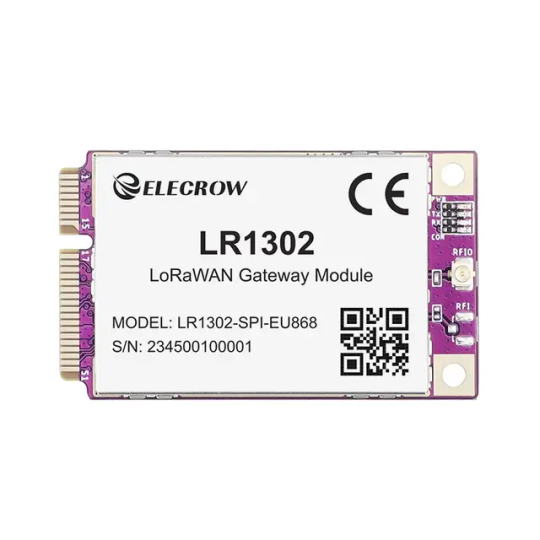


📢 #Elecrow Lora Series Product #NewArrival 👋
⭐ Introducing the LR1302 #LoRaWAN Long Range Gateway Module, which supports 8-channel data transmission for the connection and data transmission of more devices.🔥
📌https://www.elecrow.com/lr1302-lorawan-gateway-module-spi-eu868-sx1302-long-range-gateway-module-support-8-channels.html?utm_source=tumblr&utm_term=idd=2
#WirelessCommunication#InternetOfThings#SmartCity#IoTDevices#LPWAN#SensorNetworks#SmartHome#IndustrialIoT
1 note
·
View note
Text
What is the difference between the LoRaWAN wireless module and LoRa gateway wireless transmission technology?
Many individuals find it challenging to differentiate between the LoRaWAN wireless module and LoRa gateway wireless transmission technology, as well as their applications within the realm of IoT.

LoRaWAN specifically pertains to the networking protocol found within the MAC (Media Access Control) layer. In contrast, LoRa serves as a protocol within the physical layer. Although current LoRaWAN networking implementations utilize LoRa as the physical layer, it's worth noting that the LoRaWAN protocol also allows for the use of GFSK (Gaussian Frequency-Shift Keying) as the physical layer in specific frequency bands. From a network layering perspective, LoRaWAN can adopt various physical layer protocols, just as LoRa can serve as the physical layer for other networking technologies.
LoRa, as a technology, falls under the category of LPWAN (Low-Power Wide-Area Network) communication technologies. It represents an ultra-long-distance wireless transmission method based on spread spectrum technology, pioneered and promoted by Semtech in the United States. This approach revolutionizes the previous trade-off between transmission distance and power consumption, offering users a straightforward system capable of achieving extended range, prolonged battery life, and increased capacity. Consequently, it expands the capabilities of sensor networks. Currently, LoRa predominantly operates within free frequency bands globally, including 433/868/915MHz, among others.
On the other hand, LoRaWAN wireless communication stands as an open standard defining the communication protocol for LPWAN technology based on LoRa chips. LoRaWAN defines the Media Access Control (MAC) layer at the data link level and is overseen by the LoRa Alliance. It's crucial to distinguish between LoRa and LoRaWAN because companies like Link Labs utilize a proprietary MAC layer in conjunction with LoRa chips to create more advanced hybrid designs, such as Link Labs' Symphony Link.
LoRaWAN typically employs a star or star-to-star topology, which is generally considered superior to mesh networks due to advantages such as conserving battery power and extending communication range. In a star topology, messages are relayed to a central server through gateways, and each end node can transmit data to multiple gateways. These gateways then forward the data to the web server, where tasks like redundancy detection, security checks, and message scheduling are executed.
In summary, LoRa encompasses solely the link layer protocol, making it suitable for point-to-point (P2P) communication between nodes. In contrast, LoRaWAN includes the network layer, allowing data to be sent to any base station connected to a cloud platform. By connecting the appropriate antenna to its socket, the LoRaWAN module can operate at different frequencies, offering versatility in its applications.
0 notes